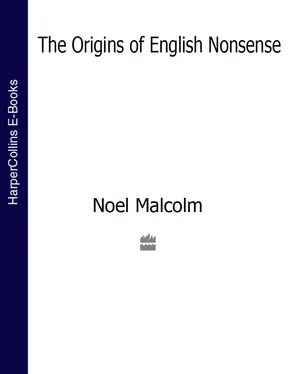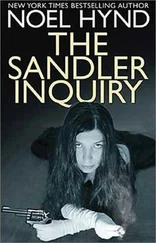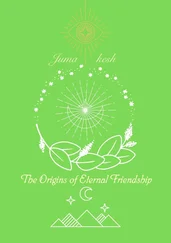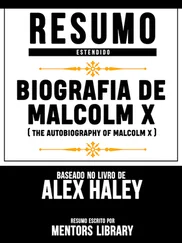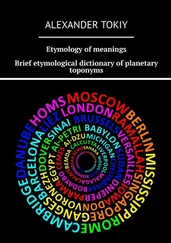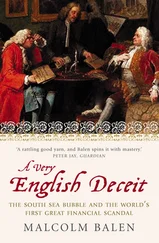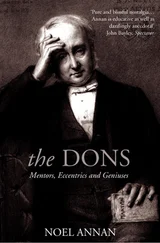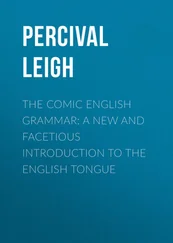It is quite possible that Sacchetti had also come across specimens of absolute-nonsense fatrasies; this cannot be proved, though it is known that French ‘jongleurs’ did visit Florence during the fourteenth and fifteenth centuries. 38Whether prompted in this way or not, Sacchetti seems to have developed what was, for Italian readers, a new form of nonsense poetry: something much more concentratedly nonsensical than any verses in the resverie-frottola tradition. His most famous poem in this style was the following:
Nasi cornuti e visi digrignati,
nibbi arzagoghi e balle di sermenti
cercavan d’Ipocrate gli argomenti
per mettere in molticcio trenta frati.
Mostrava la luna a’ tralunati,
che strusse già due cavalier godenti;
di truffa in buffa e’ venian da Sorenti
lanterne e gufi con fruson castrati.
Quando mi misi a navicar montagne
passando Commo e Bergamo e ’1 Mar rosso,
dove Ercole ed Anteo ancor ne piagne,
alor trovai a Fiesole Minosso
con pale con marroni e con castagne,
che fuor d’Abruzzi rimondava il fosso,
quando Cariodosso
gridava forte: ‘O Gian de’ Repetissi,
ritruova Bacco con l’Apocalissi’. 39
Horned noses, teeth-gnashing faces,
Sophistical kites and bales of vine-branches
Were seeking arguments from Hippocrates
For putting thirty friars in tanning vats.
The moon was showing itself to staring eyes;
It had already melted two pleasure-taking gentlemen;
From Truffa in Buffa and from Sorrento there came
Lanterns and owls with castrated finches.
When I began to navigate mountains
Passing Corno and Bergamo and the Red Sea,
Where Hercules and Antaeus are still weeping,
I then found Minos at Fiesole
With shovels, mattocks and chestnuts,
Cleaning up the ditch outside the Abruzzi,
When Cariodosso
Cried out loud: ‘Oh, Giovanni de’ Repetissi
Rediscovers Bacchus with the Apocalypse!’
This style of absolute nonsense was developed in a desultory way by a few other late fourteenth- or early fifteenth-century poets, notably Andrea Orcagna (who died in 1424). 40Later in the fifteenth century, however, it became almost a popular fashion, thanks to the talents of one highly idiosyncratic poet who took up the genre and made it his own: the Florentine Domenico di Giovanni, who was known by his nickname, ‘il Burchiello’.
Born in 1404, Burchiello developed some contacts with literary circles in Florence while plying his trade as a barber in the 1420s. He had to leave the city (either for political reasons or, more probably, because of unpaid debts) in the early 1430s; in 1439 he was imprisoned in Siena for theft and brawling. He later moved to Rome, where he resumed his trade before dying in early 1449. 41In addition to his nonsense poems, he also wrote comic and satirical poetry of extraordinary vividness and verbal density. All his poems seem to have been written for the delight of his friends; they were collected only after his death (in many cases from people who had learned the verses by heart). Once his poetry began to be published in 1475, its wider popularity was assured: there were ten further editions in the fifteenth century, and eleven during the sixteenth. 42Lorenzo de’ Medici kept only seven books in his bedroom: the Gospels, Boethius, a medical treatise, Dante, Petrarch, Boccaccio, and Burchiello. 43
Конец ознакомительного фрагмента.
Текст предоставлен ООО «ЛитРес».
Прочитайте эту книгу целиком, купив полную легальную версию на ЛитРес.
Безопасно оплатить книгу можно банковской картой Visa, MasterCard, Maestro, со счета мобильного телефона, с платежного терминала, в салоне МТС или Связной, через PayPal, WebMoney, Яндекс.Деньги, QIWI Кошелек, бонусными картами или другим удобным Вам способом.
